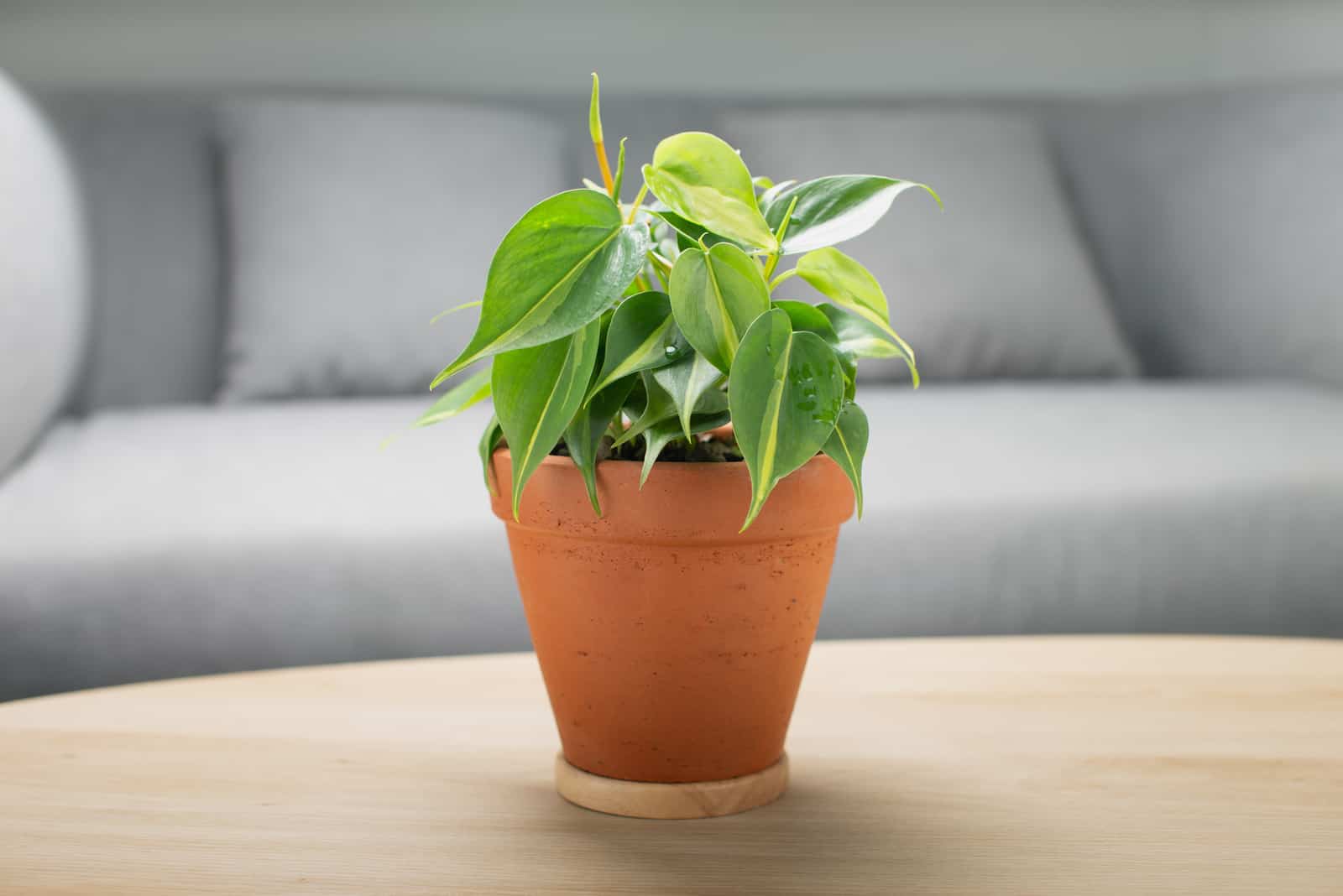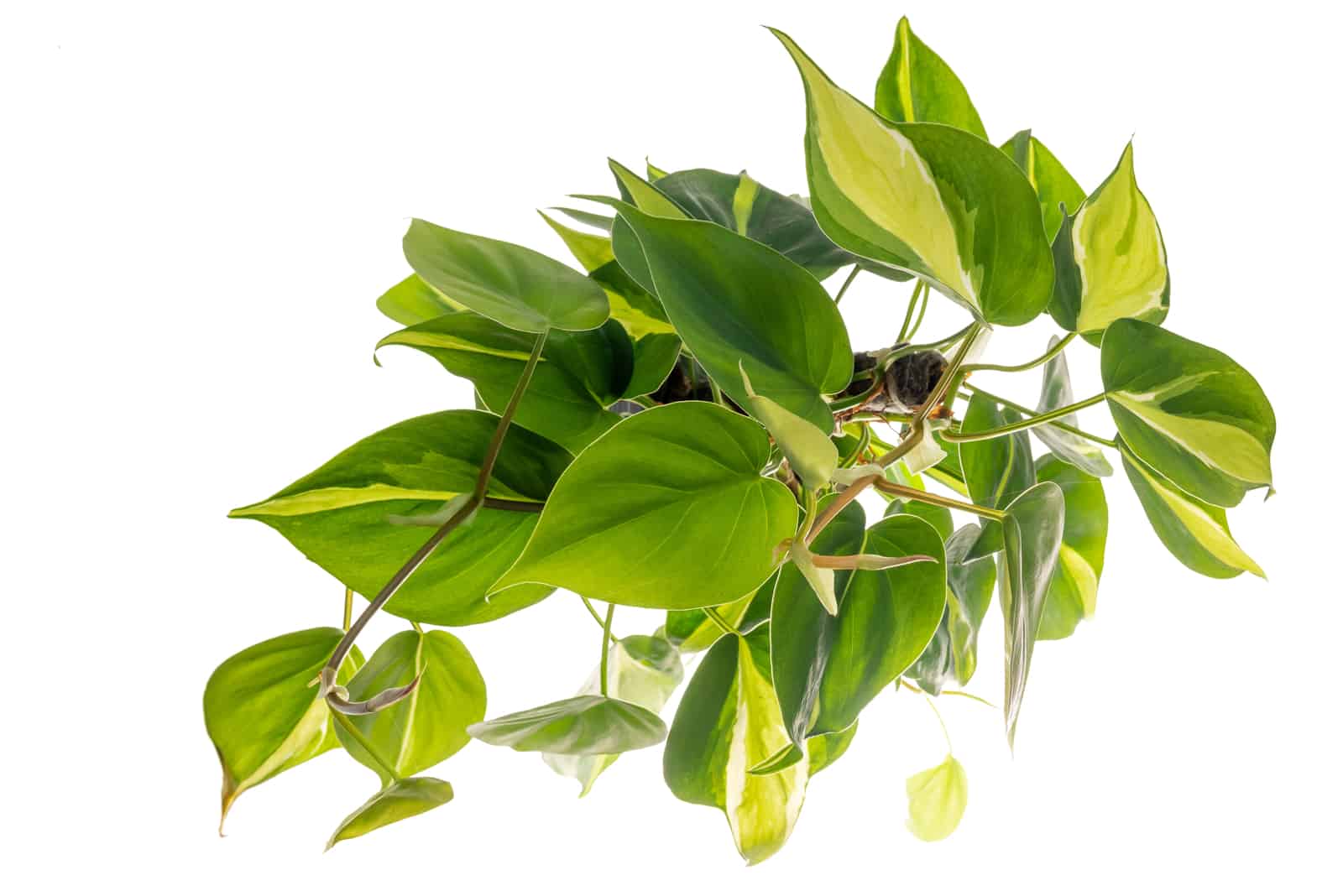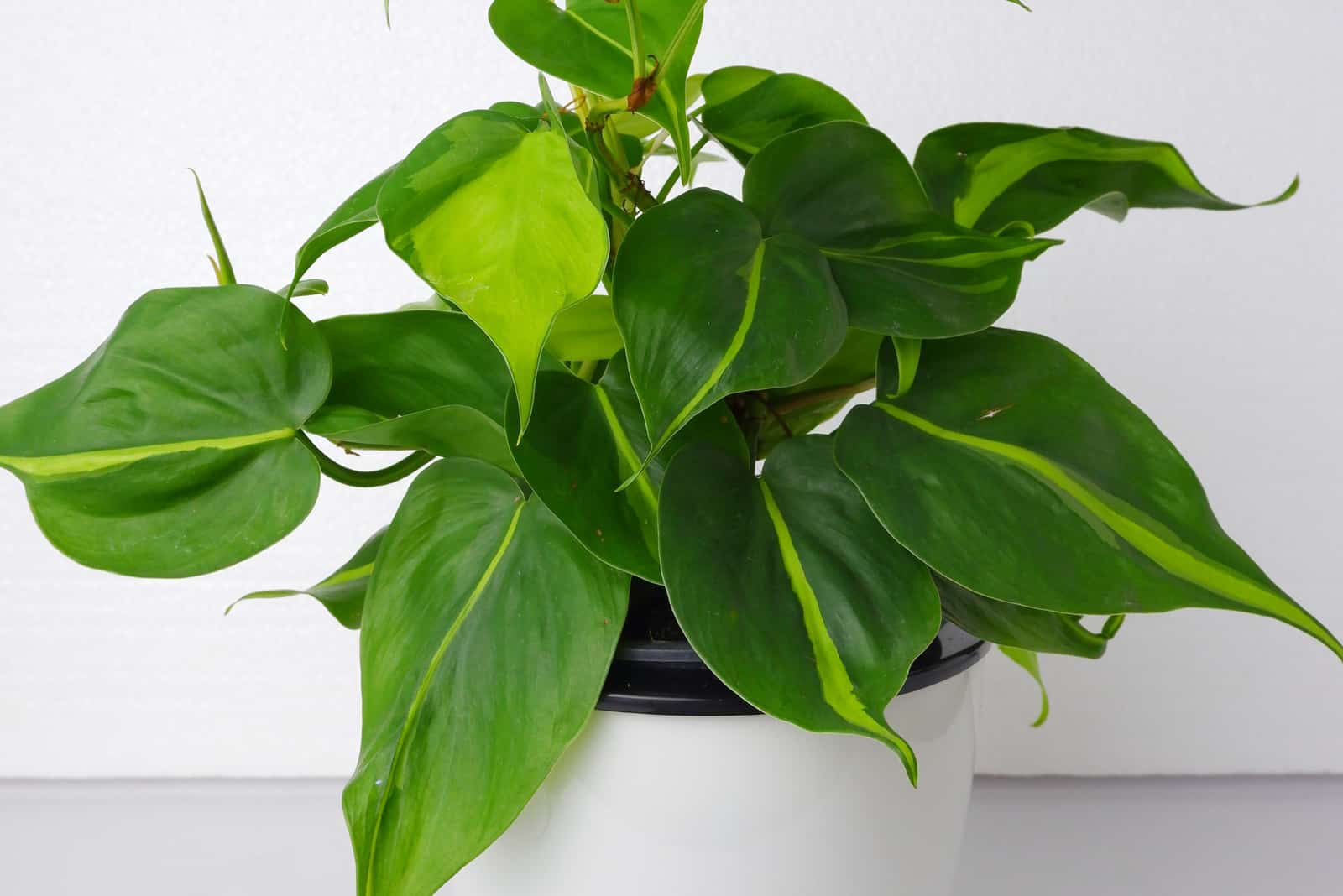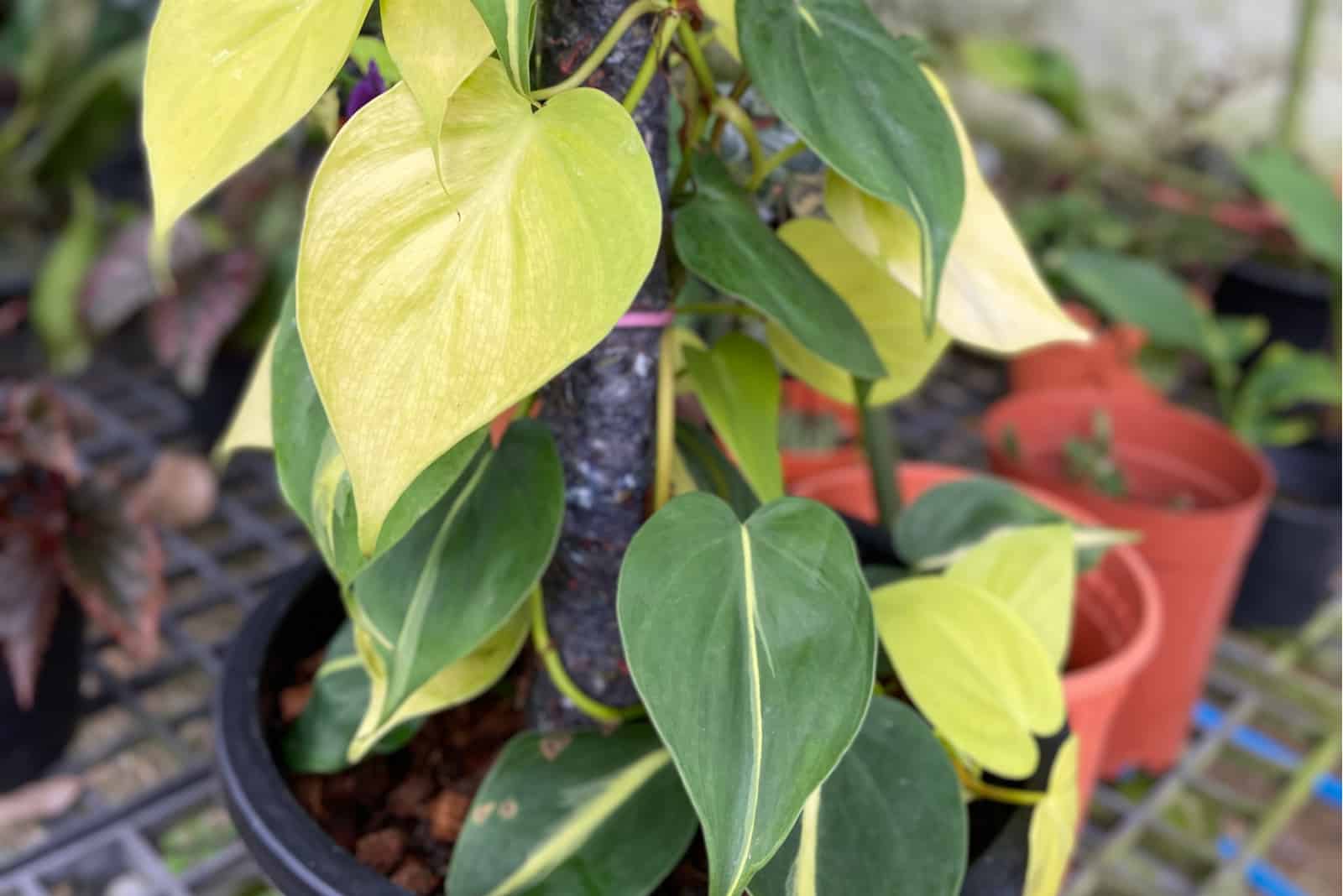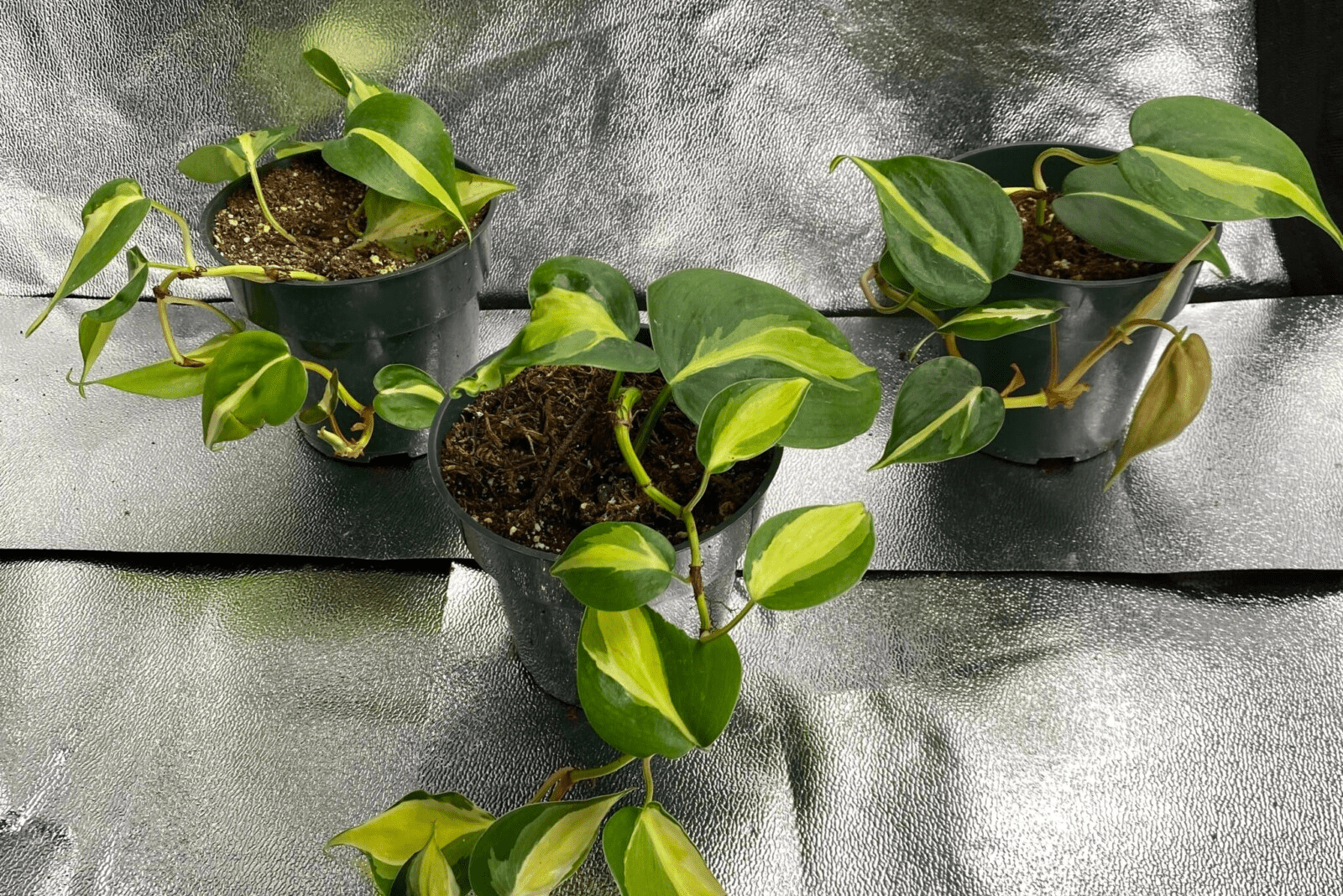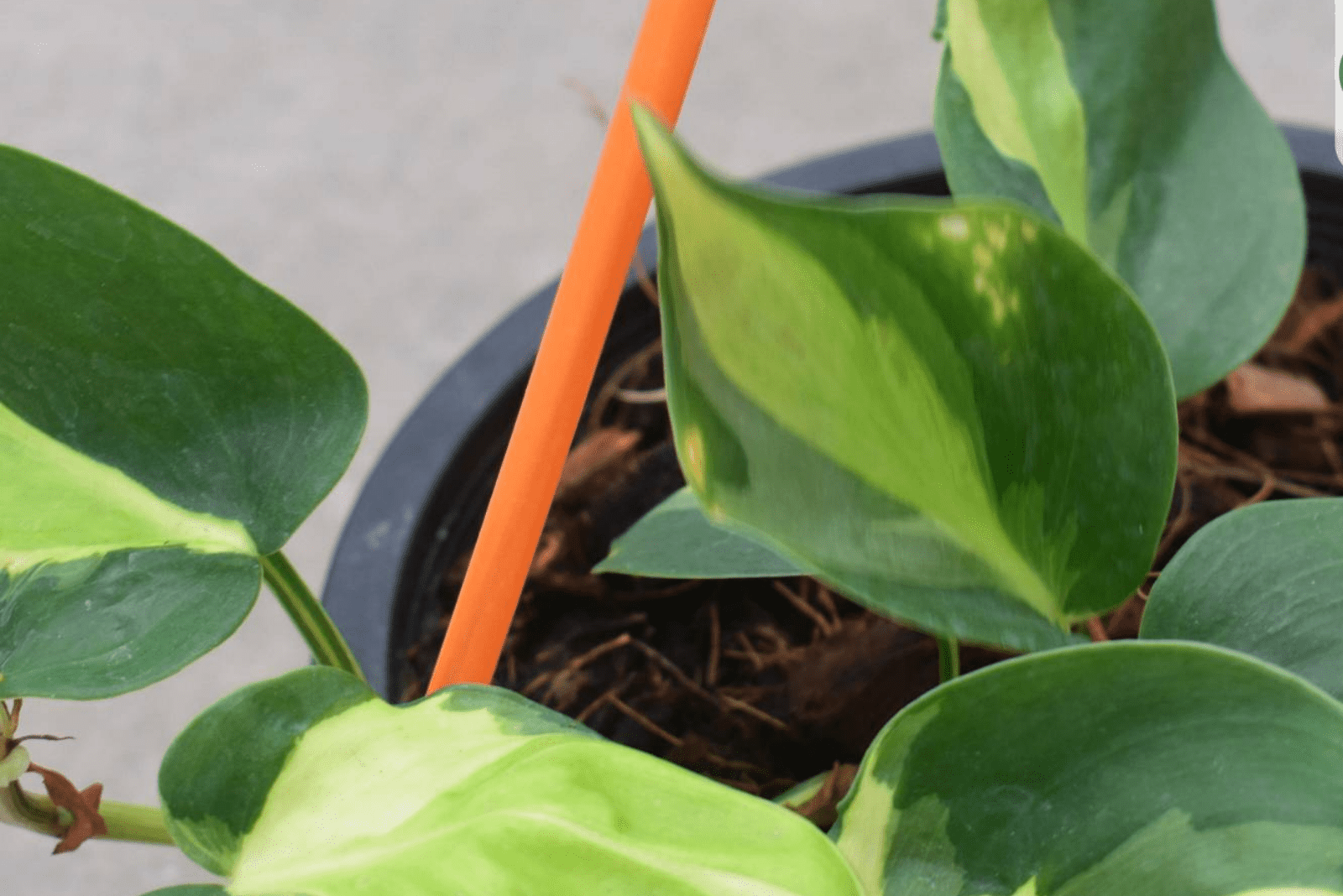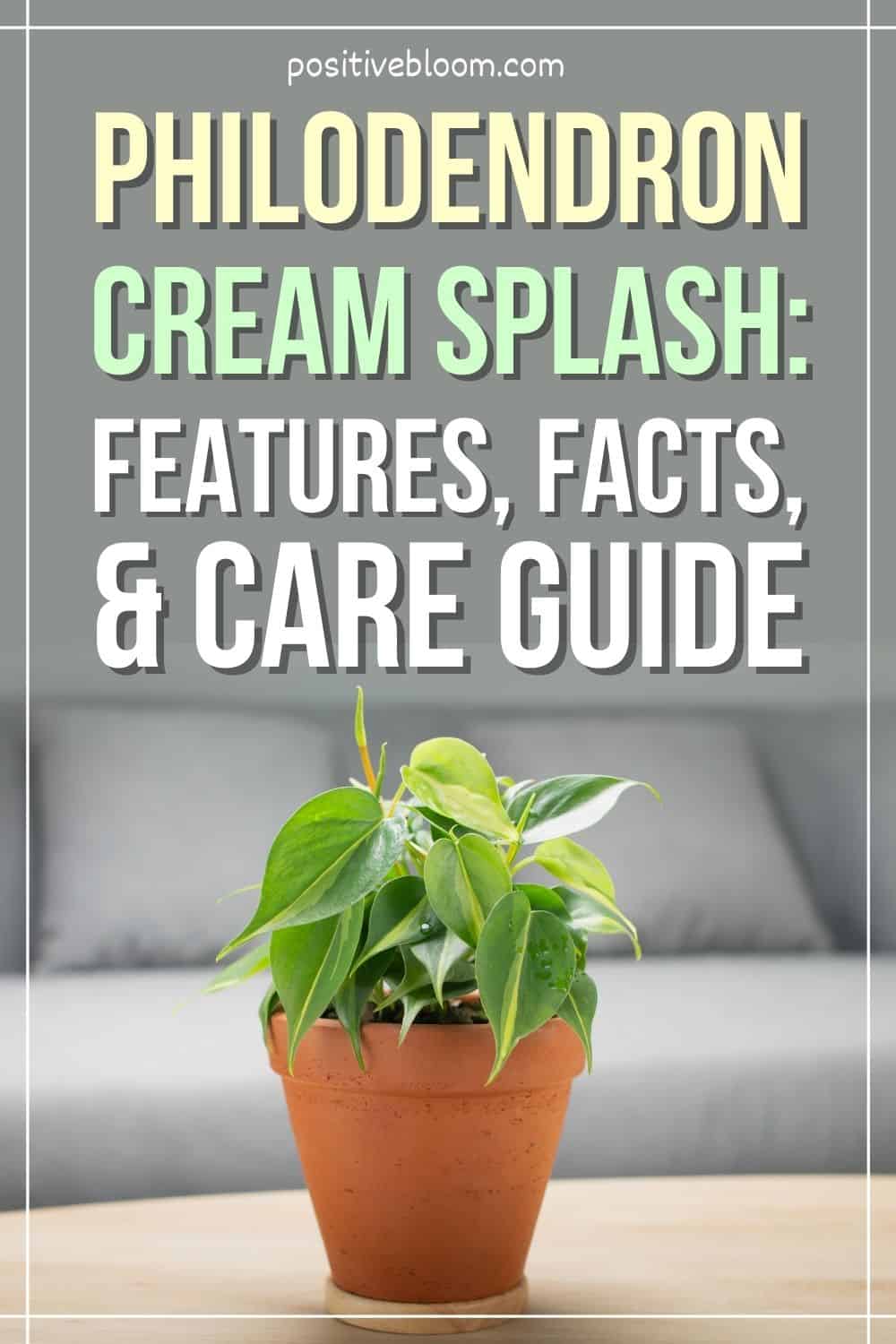Philodendrons are ideal plants for beginner gardeners, and the philodendron Cream splash is another variegated variety that you simply have to have in your home.
It is ideal for modern home decor, and its creamy and green colors can bring relaxation to your workspace, just like that.
Here is the basic information about this philodendron:
[table id=109 /]In this article, you can find out everything you need to know about the philodendron Cream splash; we bring you the plant care tips, some common issues you should avoid, the main features, and some fun facts, where you can read about other very similar philodendron cultivars.
Now, get ready because we have plenty of work to do!
Features Of The Philodendron Cream Splash
This philodendron variety looks stunning, and it will fit in any home decor.
In this section, you can read about this plant’s main features and decide whether it is the right choice for you.
Foliage
The philodendron’s foliage is its most attractive feature. The first thing you will notice is the color and the variegation pattern of this plant.
The dark green background is contrasted with randomly placed patches of cream. The dark green leaves are oval or heart-shaped and usually 11-12 inches (28-30 cm) in size.
If you want to emphasize its variegation, combine it with an all-green plant, such as philodendron Imperial Green.
Flowers
Even though this heart leaf philodendron is mainly cultivated for its leaves, it is known to produce white flowers in perfect conditions.
However, the inflorescence enclosed by a spathe rarely occurs in potted plants, but you’re not missing out on much.
Fun Facts
The Philodendron Cream splash has an interesting origin, and it is often confused with other cultivars of Philodendron hederaceum.
In this section, you can read about this philodendron’s history and meet some other cultivars and learn about their most prominent features so you can make a clear distinction between the philodendron Cream splash and other varieties.
Background
The Philodendron Cream splash is a plant discovered not so long ago. It was documented in 2009, and what’s impressive about this variety is that its variegation is caused by a natural mutation.
Most cultivars are typically bred by humans, but this philodendron results from a naturally occurring mutation.
It is a variety of Philodendron hederaceum and is often confused with its other cultivars.
You can find out why in the next section.
Similar Cultivars
Below you can find a list of cultivars similar to our philodendron Cream splash.
You will learn how to differentiate between these varieties, but even if you get confused and get the wrong type, don’t worry!
They are all low-maintenance plants that will keep your monstera good company.
The Philodendron Rio
The Rio is a unique plant with a silver line in the middle of its variegation. Its foliage is more pointed, and the creamy parts pale as they extend.
The Philodendron Gabby
The Gabby is mainly cream, with just a patch of light green. Its foliage is usually more rounded than the other varieties.
The Philodendron Silver Stripe
The Philodendron Silver stripe and Rio are very similar as they both have silver stripes in their variegations.
However, you can easily tell the difference between them. The philodendron Silver stripe is light green in the middle, and that color fades to cream and eventually becomes silver, and it is the silver line that separates the variegation from the dark green background.
The Philodendron Brasil
The Brazil has darker colors, and the variegation is more yellow than white.
Just like the other abovementioned varieties, the incised petiole and pointed tip create the heart-shaped foliage.
Care Guide For Philodendron Cream Splash
The philodendron Cream splash is a low-maintenance plant that requires very little attention, which makes it perfect for busy people, just like philodendron Mexicanum.
You only need to place it somewhere where it can get indirect sunlight and water it from time to time.
But this is not all, if you want to avoid leggy plants with pale or burnt foliage, study our care guide and step into gardening waters without a single worry.
Let’s get started!
Light
The Philodendron Cream splash is a tropical plant that loves filtered sunlight. It can tolerate low light to some extent, but this will stunt its growth, make it leggy, and its leaves will lose their vibrant colors.
You should place your philodendron where it can receive bright, indirect light; it got used to living in the protection of the tropical trees, and direct sunlight will lead to severe sunburn.
We love placing this plant beside an east-facing window, but placing it in west- or south-facing rooms also works a charm.
Just be sure to move it a few feet away from the windows so the direct sun can’t reach it.
Water And Humidity
Philodendrons love tropical climates, and you should try to reflect those conditions as much as possible.
When talking about watering habits, this philodendron loves moisture. The soil should always be moist but never wet or soggy because that can lead to root rot.
The best watering method is to irrigate the soil as soon as the topsoil is dry, which may be less frequent in winter when it enters dormancy than during its growing season in spring and summer.
However, it is better to leave this plant dry than overwater it, as overwatering leads to fungal diseases that sometimes cannot be reversed.
Humidity
The Philodendron Cream splash loves high humidity levels, and the average household humidity is usually not enough.
However, you can always keep this philodendron in the bathroom if your pothos does not already occupy that place.
But don’t worry if it is; we bring you our favorite tips for raising the humidity level!
Misting. One of the easiest ways to increase the humidity is by misting your plant once in a while. However, you always need to let the foliage dry between misting, as wet foliage often leads to diseases such as powdery mildew and leaf spot.
Pebble tray method. The pebble tray method is our personal favorite. You simply need to fill a tray, or a container of some sort, with pebbles or small rocks, pour water in it and place your potted plant on it.
The water will evaporate and increase the humidity, and the pebbles will act as a barrier and prevent any water from getting into the container.
Humidifier. Finally, if you don’t mind spending some extra money, you can purchase a compact humidifier that will raise the humidity level without endangering your philodendron.
Temperature
This Philodendron hederaceum cultivar is an ideal indoor plant that thrives best at room temperature.
However, it flourishes in temperatures between 65-85 °F (18-29 °C), so you can grow it outside if you prefer.
But, remember to take it inside when the temperatures drop below 55 °F (13 °C) because it is cold sensitive.
You should also avoid sudden temperature changes and drafts, so don’t keep it outside if it’s windy or below the AC.
Soil And Fertilizer
This philodendron variety prefers acidic to neutral soils with a pH level between 5.5 and 7.0. The planting medium needs to be well-draining and rich in organic material and nutrients.
You can add compost to your regular potting mix, which helps with water retention but also makes the soil well-draining at the same time.
We recommend getting an aroid potting mix, but you can make your own blend by mixing perlite and coco coir, which help with drainage and aeration.
You should also add sphagnum or peat moss, which retains moisture and releases it whenever the plants need some water.
Fertilizer
The Philodendron Cream splash is a heavy feeder, and it needs more nutrients than the mere soil can provide.
There are 3 fertilization techniques you can use:
1. Slow-release fertilizer. You can use a well-balanced, all-purpose, slow-release fertilizer 2 or 3 times a year. However, fertilize the plant only in spring and summer because that is when it’s actively growing.
Fertilization during dormancy can lead to over-fertilization and fertilizer burn that may cause serious harm to your plant.
2. Liquid fertilizer. A balanced liquid fertilizer, such as 19-19-19 fertilizer or 20-20-20, is ideal for philodendrons, and you can use it once a month during the plant’s growing season.
3. Diluted fertilizer. You can also use a heavily diluted general-purpose fertilizer with each watering. This method is risky, and you need to make sure that you have diluted the fertilizer in enough water so that it cannot damage your plant.
However, organic fertilizers are the best as they don’t pose any danger to your plant.
Repotting
Since philodendrons are heavy feeders, you need to repot them regularly to replenish their nutrients, because too much fertilizer can lead to salt build-up.
The best time to repot this philodendron variety is during its growing season so that the roots can adjust to the new soil.
You should repot your plant at least once a year or when you notice that it has doubled in size.
Choose a pot one size larger than its current pot, fill it with fresh potting mix, and repot the philodendron.
Propagation
The easiest propagation method is by stem cuttings, and thankfully, this philodendron responds well to this method.
First, you need to pick a healthy stem and cut it just above the leaf node. Then, you need to decide whether you want to propagate it in water or soil.
Propagation in water is much faster, and we always recommend it to beginners. You simply need to put the stem in a jar of water, place it where it can get plenty of indirect light, and wait until the root system develops.
Remember to change the water every couple of days!
After you notice the appearance of the roots, plant the stem in a pot filled with a well-draining potting mix.
Propagation in soil takes longer, but it has almost the same success rate.
Dip the cutting in rooting hormone before planting it in fresh soil. Then, all you have to do is keep the soil moist and place the pot in a bright place.
It will take several weeks to notice new growth, but you’ll get there!
Here are some tips for successful Cream Splash propagation:
Pruning And Cleaning
Pruning is an essential part of Philodendron plant care that everyone seems to ignore. Pruning your plant regularly can make it bushier, and cutting off dead foliage saves more energy, which the plant can spend elsewhere.
You can prune this philodendron to make it fit the space you reserved for it, but its size shouldn’t be a problem since this philodendron is relatively compact.
Also, pruning can help you contain the spread of diseases if you act quickly.
Cleaning
When we do house chores, we seem to forget that our houseplants also need cleaning.
Use a wet cloth to wipe the dust off and then dry the foliage. However, if you want to save some time, you can just wipe the greenery and let it dry on its own, but in that case, you shouldn’t increase the humidity any other way.
Your plant can get afflicted by fungal diseases if the humidity is too high and you don’t pat dry the foliage.
And lastly, always allow the foliage to dry before wiping it again.
Common Issues
The Philodendron Cream splash is an ideal beginner plant, not only because of its low maintenance but also because it is fairly resistant to pests and diseases.
However, it can suffer infestations and infections from time to time, and in this section, you can read how to deal with those issues if it ever comes to it.
But, as we always say, prevention is the best remedy!
Pests
This philodendron plant doesn’t get infested very often. Still, if its foliage stays wet for more extended periods or if it isn’t perfectly healthy, aphids, spider mites, or mealybugs will come and pay it a visit.
Unfortunately, these bugs are terrible guests: they make a mess and won’t leave!
The very first thing you need to do is separate the infested plant from the other plants, so that the bugs don’t invade your entire garden.
You can get rid of them by diluting rubbing alcohol in water and spraying them, but alcohol is potentially harmful to plants, so it wouldn’t be our first option.
If the infestation is not heavy, you can remove these bugs one by one with a cotton pad dipped in rubbing alcohol or with a strong spray of water.
However, if nothing seems to be working, you can always resort to neem oil and insecticides.
Diseases
This philodendron cultivar is susceptible to fungal infections such as root rot, leaf spot, and powdery mildew.
They are all caused by excess moisture and improper watering techniques. You should only water them when the topsoil feels dry to the touch and always irrigate at the soil level.
Again, the first thing you want to do if your plant gets infected is to isolate the plant, so that it can’t infect other plants you might have.
Root Rot
When it comes to root rot, you will recognize it by the drooping and wilting yellow foliage and the plant’s stunted growth.
You need to take the plant out of its pot, remove all brown or black, soggy roots, and repot the plant in a well-draining substrate that you need to keep moist, not soaking wet.
Leaf Spot And Powdery Mildew
Leaf spot and powdery mildew are usually caused by overhead watering and wet foliage, so you first need to adjust your watering technique.
You will recognize powdery mildew by white spots on the leaves, and leaf spot is characterized by yellow, brown, or black spots.
You need to prune the infected leaves, to stop the infection from spreading, as soon as you notice the first signs of one of these diseases.
Foliage infected with leaf spot needs to be pruned, but you can use certain fungicides to help save your plant from powdery mildew if you don’t want to prune it.
FAQs
Now you know all the essential things that can help you to care for your philodendron Cream splash.
However, we have saved the most exciting facts for last, and in this section, we will answer some of your most frequently asked questions about this philodendron cultivar.
Is the philodendron Cream splash rare?
The Philodendron Cream splash is not a rare plant. Even though its natural habitat is limited to Central America and some parts of South America, it is becoming more and more popular around the globe.
You can find it in many households as it doesn’t require special conditions to prosper.
This cultivar is a bit more expensive than some other philodendron species, and its online prices vary between $30-$70.
But, it’s worth spending some extra cash on this living art.
Will the philodendron Cream splash revert?
The Philodendron Cream splash can revert if its requirements aren’t met, meaning that if it doesn’t get enough sunlight, it will lose its variegations, and its striking foliage will turn green.
The reversion can also happen if you expose this plant to extreme heat or cold, as it is somewhat sensitive and prefers warmer temperatures.
If the leaves turn all green, you should cut off the affected leaves because the loss of variegation can spread to the entire plant due to the chlorophyll.
What are the pros of the philodendron Cream splash?
One of the main benefits of this philodendron cultivar is that it filters air and removes toxic gasses, such as formaldehyde and benzene, that are found in most homes.
Also, this plant’s variegations make it desirable for anyone as it makes a great addition to home decor and lightens up the space.
Its large leaves make it impossible to look away from, and all your friends and family will be talking about your fantastic design.
Plants are also known to alleviate stress and anxiety, so you can surround yourself with a philodendron Cream splash and other varieties when you’re reading a good novel.
Trust me; it’s an unforgettable experience.
What happens if you eat the philodendron Cream splash?
All philodendrons are mildly to moderately poisonous as all parts of the plant contain calcium oxalate crystals, which may cause vomiting, diarrhea, a burning sensation and pain, and the swelling of the mouth, lips, tongue, and throat.
Chewing or eating any part of this philodendron may also cause difficulties in breathing.
If you’re pruning or propagating this philodendron, you should wear gloves because this plant’s sap can cause severe skin irritation. You should also protect your eyes as you don’t want to know what may happen if some part of this plant lands in your eye.
The Philodendron Cream splash is also toxic to dogs and cats, so you’ll need to put it somewhere that they can’t get to it.
If ingested, it causes irritation and swelling of the mouth, tongue, and lips, excessive drooling, difficulty swallowing, and vomiting.
To Wrap Up
Despite its moderate toxicity, we can conclude that the philodendron Cream splash is a fascinating plant.
They are easy to maintain, and with just a little care, you can have the best-decorated house in your friends’ circle.
They only need plenty of indirect sunlight, a little bit of water, and well-draining soil for healthy growth. If you take good care of it, it will fill your home with amazing variegations.
It is also quite pest and disease resistant, but if you overwater it and don’t give it enough sunlight, it can get infested with pests and get fungal diseases.
Even though you now know how to treat these issues, it is best that it never comes to that.
In addition to all this, you also know how to differentiate this philodendron from similar cultivars. If you need more practice, you can always play our game where you and your friends buy different kinds of philodendrons and guess which is which.
Philodendrons are an indispensable part of every plant-loving human, and we hope you enjoy this variety.
Until next time!
Like this post? Share or pin it for later!

